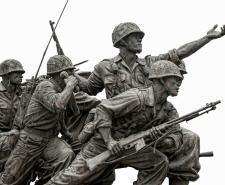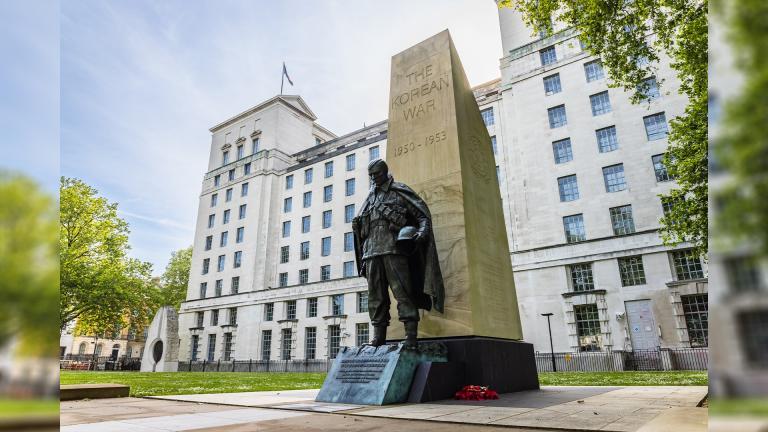
Read more about American History

The Korean War is often remembered in grainy photographs of U.S. Marines slogging through mud or of General Douglas MacArthur in his famous cap. But Britain, too, was there. And at Sky HISTORY, we’re here to prove the country’s role was far more than a footnote.
Between 1950 and 1953, around 60,000 British troops served in Korea. Regular soldiers and National Service conscripts alike. They fought in the same mountains, in the same bitter cold, and under the same impossible odds as their American allies.
At dawn on 25th June 1950, North Korean forces surged across the 38th parallel. The United Nations called on its members to act, and Britain answered. Even though its own military was still reeling from World War II.
It was a heavy demand. That earlier conflict had cost 384,000 service personnel and 70,000 civilians. This includes 40,000 Londoners killed during the Blitz. Those losses were still fresh. Sending troops to another war, half a world away, was no small decision.
Britain was hardly alone. Alongside the U.S. commitment of 300,000 troops came forces from Australia, Canada, Turkey, Ethiopia, Colombia and more, making Korea one of the first truly international UN wars.
In August 1950, the first British units waded ashore at Busan. They joined American and South Korean soldiers in a desperate defence of the peninsula’s southeast corner. For weeks, UN troops clung to what became known as the Pusan Perimeter.
Then, in September, came the gamble that changed the war. General MacArthur’s audacious amphibious landing at Incheon split the North Korean lines. British soldiers were among those who pushed north in the autumn advance, reaching the Yalu River on the border with China by November.
For those who served, Korea was a land of extremes. Summers baked the ground dry, and winters plunged to minus 30. The mountains showed little mercy for those unfamiliar with the terrain.
Most of the men were National Service conscripts, barely out of their teens. One day they were learning to drill in Primary Training Centres (PTCs) in places like Aldershot or Catterick. The next, they were crouched in foxholes on frozen hillsides. Many admitted later that they hadn’t known where Korea was when they first heard they were being sent.
'I think it’s a forgotten war,' recalled Cedric 'Ned' Egglestone of the Royal Australian Infantry Corps, who served alongside British units. 'We’ve sort of been overshadowed because it was so close to WWII.'
The bloodiest test came on the banks of the Imjin. In April 1951, the 29th British Independent Infantry Brigade Group found itself directly in the path of the Chinese Spring Offensive. Vastly outnumbered, they held their ground for three days.
When the line finally broke, more than 500 men were captured, among them their commander, Lieutenant Colonel James Carne. There were also dozens of casualties, most from the 1st Battalion, Gloucestershire Regiment, famously dubbed the 'Glorious Glosters'.
It wasn’t for nothing though. Their stubborn stand delayed the Chinese advance long enough for UN forces to regroup on stronger defences. It was a sacrifice that may have spared Seoul from immediate capture.
Britain’s role went beyond the trenches. 50 Royal Navy warships (similar to vessels like aircraft carrier USS Enterprise) patrolled Korean waters, launching bombardments and carrier strikes. 17,000 sailors served during the conflict.
The Royal Air Force contributed as well, flying maritime patrols from bases in Japan. It was a full-scale commitment, just without the headlines.
The price was heavy. Almost 1,100 British soldiers were killed. Nearly 900 now lie in the United Nations Memorial Cemetery in Busan.
The U.S. losses were far greater. More than 37,000 dead, which helps explain why the war is remembered primarily as an American fight. But for the families of the British fallen, numbers are no comfort. Each loss was personal, and each life was irreplaceable.
For Koreans, the toll was catastrophic. More than 225,000 South Korean troops were killed. Civilian casualties ran even higher. In the North, it’s estimated that 11% of the entire population died.
The fighting stopped in 1953 with an armistice, but no peace treaty was signed. Technically, the war has never ended. U.S. troops still guard the demilitarised zone, one of the most fortified borders in the world.
For those who served, Korea was never forgotten. But when they returned to Britain, it often felt as though the country had already turned the page. Still looking back to World War II and already looking ahead to the Cold War.
Only slowly has their sacrifice in a war too often called 'forgotten' been recognised.
Want more insights like this? Become a Sky HISTORY newsletter subscriber and get articles, updates and more direct to your inbox.